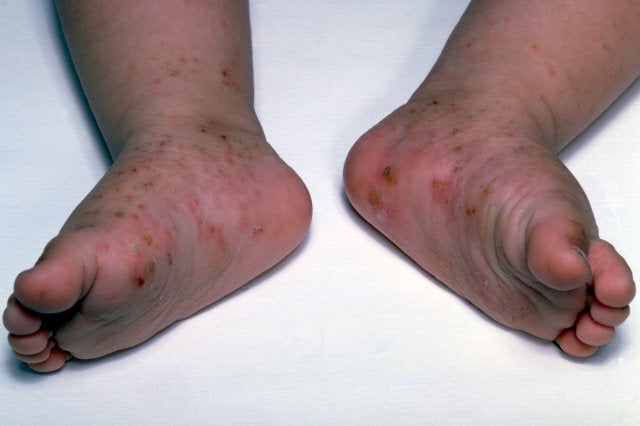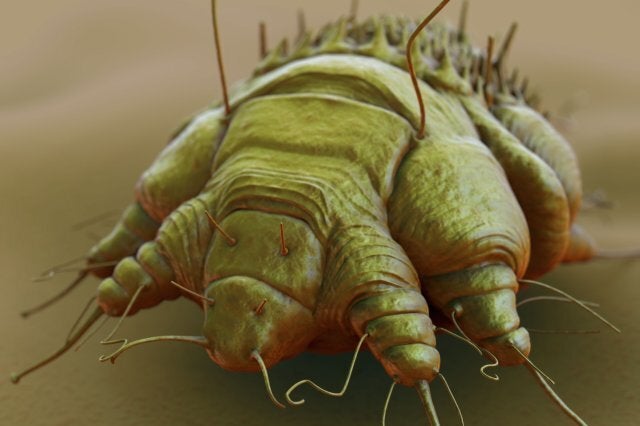
There are some aspects of parenthood which just have a bit of the ick factor – and scabies is probably one of them!
What is it?
Scabies is caused by a microscopic mite, which burrows under the skin. As it burrows, it leaves behind faeces and eggs, and this causes an allergic reaction in the body, resulting in a red, bumpy, very itchy rash.
Anyone can get scabies but young children are more prone, probably because they tend to interact in close proximity. Scabies also tends to be more common during the winter months, and this is likely to be because children spend more time indoors during this time.
The first time a child gets scabies, it might take four to six weeks before they, or you, notice the symptoms and especially the itching. If your child gets scabies again, their rash and itching will appear within a couple of days, because their immune system will recognise the infection quicker.
Often the rash will appear between the fingers or on the hands and wrists. But it can also appear under the armpits, on the face, legs, belly, scalp, knees, palms, soles of the feet and the nappy area. In particular, the mites like warm, folded areas of skin.

mite that causes scabies
As well as the rash (which will be scattered, red bumps and might develop into pus-filled blisters), you might be able to see faint, wavy silver lines, which show where the mite has burrowed under your child's skin.
Because scabies can be very itchy, particularly at night time, your child is likely to scratch – this in itself can result in sore, broken patches of skin and lead to secondary bacterial infections.
Scabies is very contagious. Your child will have picked up from being in contact with somebody else who has it, and it can sweep around nurseries. If you don't treat your child, and indeed your house, immediately, it could spread around the family.
What can I do?
If you suspect your child has scabies, go straight to your doctor, because the sooner your child is treated, the sooner their symptoms will abate, and the less likely they are to spread the scabies around.
Once your child has been diagnosed, they will be prescribed with a medicated cream containing an insecticide to kill the mites. Your doctor will advise you, but usually this cream needs to be applied to every inch of the body, from the neck down. Some creams also need to be applied to the face and scalp.
When applying the cream, pay special attention to any areas favoured by those pesky mites, but leave no skin untreated – you should even apply the cream under the finger nails with a cotton bud. The cream needs to be left on for up to 24 hours (again, your doctor or pharmacist will advise you) and if any of the cream gets washed off accidentally in the meantime, it should be reapplied.
After the correct amount of time, wash all the cream off your child's skin with water. You might need to repeat this procedure a week later. It's usually better to apply the cream at night, because your child it less likely to rub it off, or to be constantly putting their hands in their mouth while they sleep. If they tend to suck their thumb or fingers at night though, you might need to put mitts on them, so they don't ingest the cream.
When you have applied the cream to your child, strip their bed and wash all the linen. Wash any towels and clothes they have used, too. Throw in soft toys, slippers – anything they have worn or had close contact with. Put it all through a hot wash, and tumble dry as well, if you can. The heat will help to kill any mites or eggs.
If there is anything that can't go through the washing machine (or if there is far too much to get into one load), tie it tightly into a bin liner and don't open the bag for a week. Mites can't live for more than a few days without a human to feast on. You can gradually put things through the wash after that.
Do a thorough vacuum of the house, too. When you have finished, put the hoover bag straight into the outside bin.
If your child has been really suffering with the itching, mention this when you visit the doctor and they might also prescribe a mild steroid cream, or perhaps an oral antihistamine, which can help to reduce the itch and help children sleep better at night.
Usually, with treatment, scabies should be clearing up within a couple of weeks. If you see no improvement, go back to your doctor. They might suggest you repeat the treatment, or they might give you a new cream to try. Although the rash can settle within a fortnight, the itching can continue for a little longer.
Occasionally, children with scabies can develop complications. Scabies can, for example, lead to secondary bacterial infections, such as impetigo. If your child's rash changes, go back to your GP, because they may need an antibiotic cream.
Even more rarely, scabies can develop into something called crusted scabies, where many thousands of mites are present, and the skin has a scaled, warty appearance. This is very unusual, but people with weak immune systems – including very young babies – are more prone. So it's important to seek treatment straight away.
What else could it be?
If your baby or toddler has a red rash or blisters, but they are mostly around their nose and mouth, the might have impetigo.
More on Parentdish